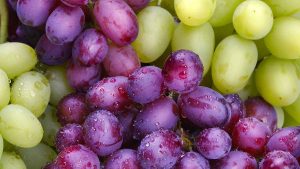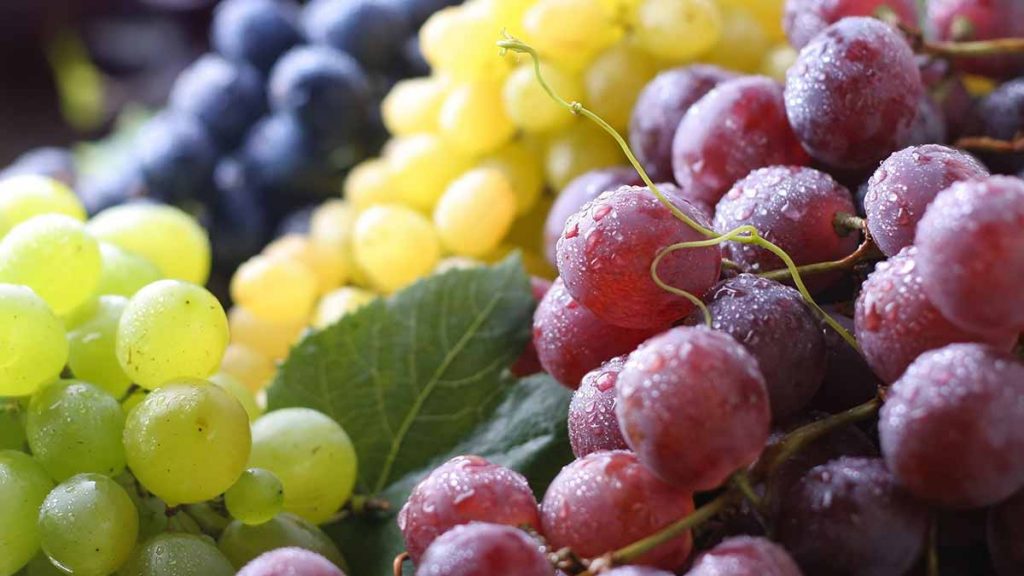

The Canadian grape industry has grown tremendously over the past four decades and production is concentrated in warm weather regions like the Niagara Peninsula in Ontario, the Okanagan Valley in BC, Montérégie in Quebec and the Annapolis Valley in Nova Scotia. The majority of grapes grown in Canada are used in the wine industry but there are also several table grape growers.

Table grape varieties are grown to be more physically appealing than their wine grape counterparts. They are bigger with a thicker pulp and thinner skin, whereas wine grapes have a thicker skin, more seeds and a higher juice and sugar content. Table grapes come in an assortment of colours including, green, shades of pink to red, purple and blue. They are also classified by their seeded or seedless traits.
Look for plump, even coloured grapes with firm skins that are securely attached to the vine. The vine should be light green or pale gold and flexible, not brittle.

Avoid fruit with dark spots, packages with lots of soft or wrinkled grapes and extra moisture. Grapes with brown stems that fall off the vine easily are overripe and will spoil quickly.
Fresh grapes should smell sweet. Overripe grapes give off a fermented or vinegar smell when they start to spoil.
Check your bag when you get home and remove any soft or mushy grapes to prevent the rest of the package from spoiling quickly.

Store in the high humidity crisper drawer of your fridge for up to a week in their original packaging or a ventilated plastic container or bag. Do not wash until ready to eat because extra moisture will cause them to spoil faster. Keep them away from foods with strong odors, like onions and garlic, as the grapes will take on those smells.
To freeze, rinse well and remove from the vine. Pat dry and arrange in a single layer on a parchment lined cookie sheet then place in the freezer for 4 – 6 hours, or until frozen. Transfer frozen grapes to a sealed container or sealable bag and store for 3 – 5 months.
Frozen grapes make a great summer treat and resemble sorbet when eaten whole. Substitute them for ice cubes in your punch, cocktails and white wine or add them to smoothies. Try to use within the first four weeks as frozen grapes lose their flavour quickly and use directly from frozen as thawed grapes are mushy and unappealing.

Grapes make a great snack and can be eaten whole or sliced. Add them to salads, yogurt, granola, smoothies. Use older grapes to make homemade jams, jellies or toppings for pancakes or waffles.
Cooking fresh grapes often diminishes their flavour but quick-roasted grapes (toss with 1 tablespoon (15 mL) canola oil and roast at 450 degrees F for 25 minutes) can make a good addition to chicken and lamb dishes.
Grapes are a source of Vitamin C, antioxidants and fibre.

Grapes grow on woody climbing vines that produce clusters of berries. They are grown in irrigated orchards using a trellis system. As the vines grow they are ‘trained’ or ‘formed’ up the trellis which lets the grapes hang independently from each other and reduces rubbing of the fruit on other grapes, leaves and stems so as not to damage the thin skins. A mature grapevine will produce 15 – 30 lbs of grapes per vine.

Ontario’s Niagara Peninsula is the country’s leading grape producer, accounting for over 60% of Canada’s production, however, the majority of their grapes are grown to supply their thriving wine industry. The Okanagan and Similkameen valleys in south-central British Columbia are also home to a large portion of Canada’s wine grape production. Smaller grape-growing regions include southern Ontario and Québec, Vancouver Island, and New Brunswick, Nova Scotia and Prince Edward Island.
Because table grapes generally require a longer growing season to reach optimal size and sweetness, the number of varieties available to Canadian grape growers is limited. However, ongoing research is focusing on finding more short-season, winter hardy table grape options for Canadians to enjoy locally.
Canadian crop is available: August – September
Grown in: Ontario, BC, Quebec, Nova Scotia